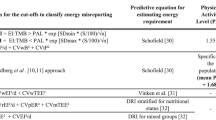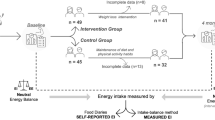Abstract
Objective: To identify adults and children as under- (UR), acceptable (AR), or over-reporters (OR) of energy intake (EI) using energy expenditure measured by doubly labelled water (DLW) (EEDLW), and to use this as a reference to determine the sensitivity and specificity of (i) EE measured by heart rate (EEHR), and (ii) the Goldberg cut-off technique for classifying subjects into the same categories.
Design: Retrospective analysis of a dataset comprising concurrent measurements of EEDLW, EEHR, basal metabolic rate (BMR), and EI by weighed record (EIWR) on 14 adults and 36 children. EI by diet history (EIDH) was also measured in the children only. EIWR:EEDLW provided the reference definition of subjects as UR, AR or OR. Three strategies for classifying mis-reporters based on EEHR and Goldberg cut-offs were then explored. Sensitivity and specificity were calculated respectively as the proportion of UR and non-UR correctly identified.
Results: Approximately 80% of all subjects were AR. For EIWR and EIDH respectively, the sensitivity of EEHR was 0.50 and 1.00, and specificity was 0.98 and 1.00. Although designating subjects as having low, medium or high activity levels (EEHR:BMRmeas) and calculating cut-offs based on appropriate WHO physical activity level PALs did not change sensitivity, specificity dropped to 0.98 (EIWR) and 0.97 (EIDH). Cut-offs based on a PAL of 1.55 reduced sensitivity to 0.33 (EIWR) and 0.00 (EIDH), but specificity remained unchanged. The sensitivity of all cut-offs based on physical activity level (PALs) for EIWR was 0.50 (adults) and 0.25 (children).
Conclusions: If the precision of EEHR was improved, it may be useful for identifying mis-reporters of EI.
This is a preview of subscription content, access via your institution
Access options
Subscribe to this journal
Receive 12 print issues and online access
$259.00 per year
only $21.58 per issue
Buy this article
- Purchase on Springer Link
- Instant access to full article PDF
Prices may be subject to local taxes which are calculated during checkout


Similar content being viewed by others
References
Bingham, S (1987). The dietary assessment of individuals; methods, accuracy, new techniques and recommendations. Nutr. Abstr. Rev., 57, 705–742.
Black, AE, Prentice, AM, Goldberg, GR, Jebb, SA, Bingham, SA, Livingstone, MBE & Coward, WA (1993). Measurements of total energy expenditure provide insights into the validity of dietary measurements of energy intake. J. Am. Diet. Assoc., 93, 572–579.
Black, AE (1997). Under-reporting of energy intake at all levels of energy expenditure: evidence from doubly labelled water studies. Proc. Nutr. Soc., 56, 121A
Black, AE (1999). Small eaters or under-reporters?. InProgress in Obesity Research, ed. G Ailhaud & B Guy-Grand pp223–228, Paris: John Libbey
Black, AE (2000a). Critical evaluation of energy intake using the Goldberg cut-off for energy intake: basal metabolic rate. A practical guide to its calculation, use and limitations. Int. J. Obes. Relat. Metab. Disord., 24, 1119–1130.
Black, AE (2000b). The sensitivity and specificity of the Goldberg cut-off for EI:BMR for identifying diet reports of poor validity. Eur. J. Clin. Nutr., 54, 395–404.
Black, AE & Cole, TJ (2000). Within- and between-subject variation in energy expenditure measured by doubly-labelled water technique: implications for validating reported dietary energy intake. Eur. J. Clin. Nutr., 54, 386–394.
Black, AE, Prentice, AM & Coward, WA (1986). Use of food quotients to predict respiratory quotients for the doubly-labelled water method of measuring energy expenditure. Hum. Nutr. Clin. Nutr., 40C, 381–391.
Black, AE, Bingham, SA, Johansson, G & Coward, WA (1997). Validation of dietary intakes of protein and energy against 24 hour urinary N and DLW energy expenditure in middle aged women and retired men: comparison with validation against presumed energy requirements. Eur. J. Clin. Nutr., 51, 405–413.
Briefel, RR, Sempos, CT, McDowell, MA, Chien, S & Alaimo, K (1997). Dietary methods research in the third National Health and Nutrition Examination Survey: under-reporting of energy intake. Am. J. Clin. Nutr., 65, S1203–S1209.
Charlton, KE & Lambert, EV (1999). Validation of a food frequency questionnaire in older South Africans. S.A. Med. J., 89, 184–189.
Coward, WA (1988). The doubly-labelled-water (2H2 18O) method: principles and practice. Proc. Nutr. Soc., 47, 209–218.
de Vries, JH, Zock, PL, Mensink, RP & Katan, MB (1994). Underestimation of energy intake by 3-d records compared with energy intake to maintain body weight in 269 nonobese adults. Am. J. Clin. Nutr., 60, 855–860.
FAO/WHO/UNU (1985). University. Report of a joint expert consultation. Energy and protein requirements, WHO Technical Report Series no. 724 Geneva: WHO
Fogelholm, M, Männisto, S, Vartiainen, E & Pietinen, P (1996). Determinants of energy balance and overweight in Finland 1982 and 1992. Int. J. Obes. Relat. Metab. Disord., 20, 1097–1104.
Goldberg, GR, Black, AE, Jebb, SA, Cole, TJ, Murgatroyd, PR, Coward, WA & Prentice, AM (1991). Critical evaluation of energy intake data using fundamental principles of energy physiology. 1. Derivation of cut-off values to identify under-recording. Eur. J. Clin. Nutr., 45, 569–581.
Goris, AHC & Westerterp, KR (1999). Underreporting of habitual food intake is explained by undereating in highly motivated lean women. J. Nutr., 129, 878–882.
Heywood, P, Harvey, PJW & Marks, GC (1993). An evaluation of energy intake in the 1983 Australian National Dietary Survey of Adults. Eur. J. Clin. Nutr., 47, 604–606.
International Dietary Energy Consultative Group (IDECG) (1990). The doubly-labelled water method for measuring energy expenditure: technical recommendations for human applications. ed. AM Prentice Vienna: IAEA/IDECG NAHRES-4
Johnson, RK, Goran, MI & Poehlman, ET (1994). Correlates of over- and underreporting of energy intake in healthy older men and women. Am. J. Clin. Nutr., 59, 1286–1290.
Körtzinger, I, Bierwag, A, Mast, M & Müller, MJ (1997). Measurements of energy intake using a 7-day dietary record and a diet history in non-obese subjects. Ann. Nutr. Metab., 41, 37–44.
Lafay, L, Basdevant, A, Charles, M-A, Vray, M, Balkau, B, Borys, J-M, Eschwege, E & Romon, M (1997). Determinants and nature of dietary underreporting in a free-living population: the Fleurbaix Laventie Ville-Santé (FLVS) Study. Int. J. Obes. Relat. Metab. Disord., 27, 567–573.
Livingstone, MBE, Prentice, AM, Coward, WA, Ceesay, SM, Strain, JJ, Mckenna, PG, Nevin, GB, Barker, ME & Hickey, RJ (1990a). Simultaneous measurement of free-living energy expenditure by the doubly labeled water method and heart-rate monitoring. Am. J. Clin. Nutr., 52, 59–65.
Livingstone, MBE, Prentice, AM, Strain, JJ, Coward, JJ, Black, AE, Barker, ME, McKenna, PG & Whitehead, RG (1990b). Accuracy of weighed dietary records in studies of diet and health. Br. Med. J., 300, 708–712.
Livingstone, MBE, Coward, WA, Prentice, AM, Davies, PSW, Strain, JJ, McKenna, PG, Mahoney, CA, White, JA, Stewart, CM & Kerr, MJ (1992a). Daily energy expenditure in free-living children: comparison of heart-rate monitoring with the doubly labeled water (2H2 18O) method. Am. J. Clin. Nutr., 56, 343–352.
Livingstone, MBE, Prentice, AM, Coward, WA, Strain, JJ, Black, AE, Davies, PSW, Stewart, CM, McKenna, PG & Whitehead, RG (1992b). Validation of estimates of energy intake and diet history in children and adolescents. Am. J. Clin. Nutr., 56, 29–35.
Nelson, M, Black, AE, Morris, JA & Cole, TJ (1989). Between- and within-subject variation in nutrient intake from infancy to old age: estimating the number of days required to rank dietary intake with desired precision. Am. J. Clin. Nutr., 50, 156–167.
Price, GM, Paul, AA, Cole, TJ & Wadsworth, MEJ (1997). Characteristics of the low-energy reporters in a longitudinal national dietary survey. Br. J. Nutr., 77, 833–851.
Pryer, J, Vrijheid, M, Nichols, R, Kiggins, M & Elliott, P (1997). Who are the ‘Low energy reporters’ in the dietary and nutritional survey of British adults?. Int. J. Epidemiol., 26, 146–154.
Rothenberg, E, Bosaeus, I & Steen, B (1997). Evaluation of energy intake estimated by a diet history in three free-living 70 year old populations in Gothenburg, Sweden. Eur. J. Clin. Nutr., 51, 60–66.
Schoeller, DA (1990). How accurate is self-reported dietary energy intake?. Nutr. Rev., 48, 373–379.
Schofield, WN, Schofield, C & James, WPT (1985). Basal metabolic rate. Hum. Nutr. Clin. Nutr., 39C, (Suppl 1) S1–S96.
Speakman, JR (1997). Doubly Labelled Water: Theory and Practice. London: Chapman and Hall
Torun, B, Davies, PSW, Livingstone, MBE, Paolisso, M, Sackett, & Spurr, GB (1996). Energy requirements and dietary energy recommendations for children and adolescents 1 to 18 years. Eur. J. Clin. Nutr., 50, (Suppl 1) S37–S81.
Voss, S, Kroke, A, Klipstein-Grobusch, K & Boeing, H (1997). Obesity as a major determinant of underreporting in a self-administered food frequency questionnaire: results from the EPIC-Potsdam Study. Z. Ernahrungswiss, 36, 229–236.
Acknowledgements
We thank the subjects who took part in these studies.
Author information
Authors and Affiliations
Contributions
Guarantor: Dr M B E Livingstone.
Contributors: MBEL was the principal author and was responsible for executing the original adult and child cohorts. PJR participated in the conceptualisation, data analysis, drafting and critical review of the manuscript. AEB formulated the specific hypothesis and critically reviewed the manuscript. WAC was responsible for over-seeing the original doubly labelled water analysis and critically reviewed the manuscript. JMWW, McMcK, JJS and PGMcK participated in conceptualisation and helped with the drafting and critical review of the manuscript.
Corresponding author
Rights and permissions
About this article
Cite this article
Livingstone, M., Robson, P., Black, A. et al. An evaluation of the sensitivity and specificity of energy expenditure measured by heart rate and the Goldberg cut-off for energy intake: basal metabolic rate for identifying mis-reporting of energy intake by adults and children: a retrospective analysis. Eur J Clin Nutr 57, 455–463 (2003). https://doi.org/10.1038/sj.ejcn.1601563
Received:
Revised:
Accepted:
Published:
Issue Date:
DOI: https://doi.org/10.1038/sj.ejcn.1601563
Keywords
This article is cited by
-
The association between FTO genotype with macronutrients and calorie intake in overweight adults
Lipids in Health and Disease (2020)
-
Dietary glycaemic index and glycaemic load among Australian adults – results from the 2011–2012 Australian Health Survey
Scientific Reports (2017)
-
The accuracy of the Goldberg method for classifying misreporters of energy intake on a food frequency questionnaire and 24-h recalls: comparison with doubly labeled water
European Journal of Clinical Nutrition (2012)
-
Dietary intakes assessed by 24-h recalls in peri-urban African adolescents: validity of energy intake compared with estimated energy expenditure
European Journal of Clinical Nutrition (2011)
-
Evaluation of 2 × 24-h dietary recalls combined with a food-recording booklet, against a 7-day food-record method among schoolchildren
European Journal of Clinical Nutrition (2011)



